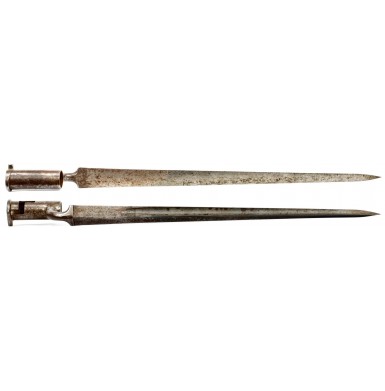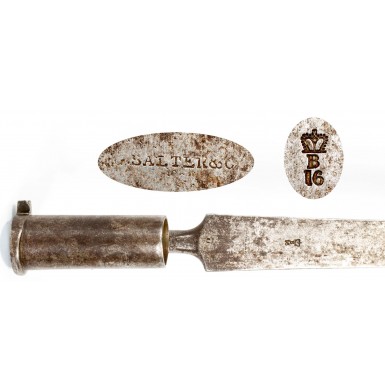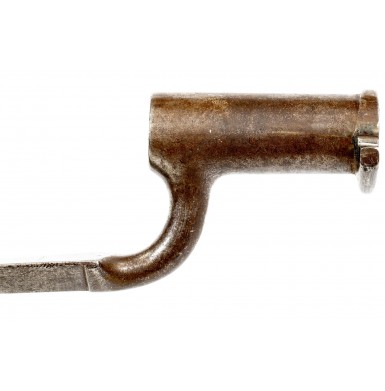British Pattern 1842 Socket Bayonet by Salter
- Product Code: EWB-2492-SOLD
- Availability: Out Of Stock
-
$1.00
This is a nice, untouched example of a British Pattern 1842 Lovell’s Catch Socket Bayonet. Although not adopted until late in 1844, the bayonet is referred to as the Pattern 1842 in most references and saw use with nearly all of the Pattern 1842 muskets produced, as well with many of the earlier Pattern 1839 muskets that were upgraded to the Lovell Catch system.
Originally, the Pattern 1839 British Musket has used the Hanoverian bayonet catch, a carryover from the short lived Pattern 1838 Musket. The Pattern 1838 was designed by the new small arms inspector George Lovell and was the first general issue percussion musket in British infantry service. The new musket utilized a back action lock mechanism inspired by the French. For a number of reasons, the Pattern 1838 musket was almost immediately replaced by the Pattern 1839 percussion musket, which utilized a conventional lock and allowed existing stocks of older flintlock parts on hand (particularly barrels, stocks, furniture, etc.) to be used up. Both muskets used the Hanoverian spring catch system under the barrel of the musket, forward of the nose cap, to secure their socket bayonets. This was a major improvement over the friction fit system that had been used for British musket bayonets through the entire flintlock era. In 1844, Lovell introduced the improvement of the Lovell’s Catch to the new Pattern 1842 musket. It was an improved spring loaded catch, located in the same location as the old Hanoverian catch, which secured the bayonet and required positive pressure from the soldier in order to release the bayonet. Over the next few years, thousands of P1842 Lovell’s catch bayonets would be produced for the new P1842 Muskets, and thousand more older P1839 bayonets would be altered to the new Lovell system. The Lovell spring catch would remain in use on the Pattern 1851 Minié Rifle as well and would eventually be replaced with a French style rotating locking ring with the adoption of the small bore Pattern 1853 Enfield Rifle Musket.
The British Pattern 1842 bayonets had nominally 17” long blades with 3” sockets and bore diameters of approximately 24mm. The sockets were mortised for top stud and had a simple 3-step “zigzag” mortise cut. These dimensions were essentially the same as the earlier Pattern 1839 Bayonet that had been used with the Hanoverian catch system. The Hanoverian version had a reinforcement ring with a rounded notch at the rear of the socket, which the Hanoverian spring catch would engage when the bayonet was secured to the musket. The later Lovell’s catch required a larger, eccentric ring at the rear of the socket that was rotated into the locking position with the catch on the musket and required the catch to be released with thumb pressure to free the bayonet. The Lovell pattern eccentric collar was reminiscent of the locking collars found on the rear of Prussian Model 1809 and Model 1839 musket bayonets, as well as Austrian Model 1799 socket bayonets. When the older P1839 bayonets were upgraded to the Lovell catch system, the old Hanoverian reinforcement ring was ground down and the new Lovell style eccentric collar was brazed over the rear of the socket. This newly installed eccentric ring would then be inspected and stamped with a {CROWN} / V inspection mark. Later, when many of the P1842 muskets were altered by rifling and sighting them, a sighting groove was cut in the collar to allow the front sight of the musket to be visible when the bayonet was mounted on the gun. Those bayonets produced as P1842 bayonets will not have the additional inspection mark on the rear face of the socket reinforcement ring.
This example of a British Military Pattern 1842 Lovell Catch Socket Bayonet is in VERY GOOD+ condition. The bayonet was produced by the famous English cutlery contractor George Salter and Company and is marked on the face of the blade G. SALTER & Co. The blade is also marked with a clear and crisp Birmingham Board of Ordnance inspection mark, consisting of a {CROWN} / B / 16.
George Salter & Company was a Birmingham manufacturer of spring steel and balances (scales) that was started in 1760 by Richard & William Salter. Upon their deaths John & George Salter took over the business and by the 1790s they had become one of the leading employers in West Bromwich (about 5 miles NW of Birmingham), continuing to manufacture springs and balances, and adding bayonets to their manufacturing capacity. For the next two hundred years, the company continued in business under the name of George Slater, and during the late 18th Century and 19th century they were one of the premier bayonet makers to produce bayonets for the British Board of Ordnance (later the War Department after about 1855) as well as for the commercial and export trade; especially to the North and South during the course of the American Civil War. During the latter part of the 19th Century, Salter returned to their original specialty and continued to expand their spring steel, spring and weighing and balance business. Salter actually continues to do business today as a subsidiary of Avery Weigh-Tronix, who acquired Salter in 2000.
The bayonet is untouched and uncleaned and has a nice, smoothly oxidized brownish patina over a dull pewter gray base color. There is some very lightly scattered pinpricking present on the blade, along with small flecks of surface oxidation and some small patches of minor surface roughness, but nothing serious or significant. The 3” socket has a nominally .92” bore diameter (about 23mm) and a 1.45” muzzle to stud distance. The blade is full-length, measuring 17.75” from the face of the neck to the tip and 17” from the blade shoulder to the tip. The overall length of the bayonet is nominally 20.75”. The socket ring does not have a notch machined into it, indicating that the bayonet was only used on the smoothbore Pattern 1839 and Pattern 1842 muskets, not the rifled and sighted versions.
As noted, the bayonet is marked by the Birmingham contractor George Salter & Co and also bears a Birmingham Boar of Ordnance inspection mark. The Salter mark is mostly clear and legible, although the “G” is weak, as is the “Co” mark. The inspection mark is deep, crisp and clear. There is no inspection mark on the rear of the socket collar, so this bayonet was produced as a Pattern 1842 bayonet and is not an earlier Pattern 1839 that was altered to Pattern 1842. The bayonet shows typical British manufacture of the era with the socket, neck and lower 5” or so the blade being of iron and the balance of the blade to the point being of steel. The socket, neck and lower portion of the blade have a more evenly oxidized brownish color, while the steel portion of the blade is more pewter gray with the scattered discoloration being more of a dark gray or black. The diagonal hammer weld line is clearly visible on the blade face at the transition between the iron and steel. Other that the few scattered flecks of surface scale and lightly oxidized roughness, the bayonet remains very crisp and sharp throughout and has a lovely, unmolested appearance. Thousands of these bayonets saw use with British troops in the Crimea and around the empire during the 1840s and early 1850s, and several thousand were imported by both sides (mostly the Confederacy) as obsolete British arms found a new market during the American Civil War.
Overall this is a very nice bayonet that is well marked and a solid example to add to the display of your Lovell catch equipped British Pattern 1839 Musket or your Pattern 1842 Musket. It would also be a nice addition to any collection of Crimean War period arms or of 19th century British military bayonets.
SOLD







